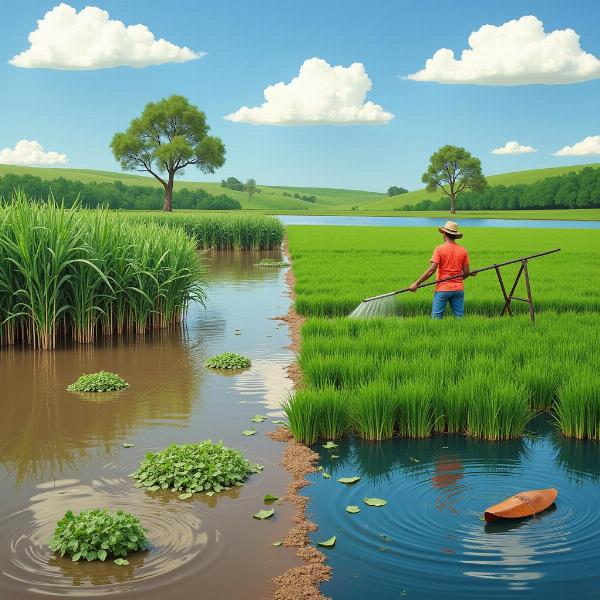Understanding the meaning of “ponding” in Hindi requires more than just a simple translation. It involves grasping the cultural context and practical implications of water accumulation, a phenomenon often experienced in India due to the monsoon season. This article explores the various Hindi words used to describe ponding, their nuanced meanings, and the significance of this concept in Indian life.
Exploring the Hindi Equivalents of “Ponding”
Several Hindi words can convey the meaning of “ponding,” depending on the specific context. जल-जमाव (jal-jamav) is a common and versatile term, literally translating to “water accumulation.” It can refer to any instance of water collecting in a stagnant manner, from small puddles to larger areas of inundation. Another frequently used term is भराव (bharav), which emphasizes the act of filling or becoming full with water. This word is particularly suitable when describing the filling up of a reservoir or tank. Other related terms include पानी जमा होना (pani jama hona), which means “water accumulating,” and पानी भर जाना (pani bhar jana), which means “water filling up.” The most appropriate term depends on the specific situation and the desired emphasis.
The Cultural Significance of Ponding in India
Ponding holds significant cultural and practical implications in India. The monsoon season, while vital for agriculture and water resources, often leads to widespread ponding, especially in urban areas. This can disrupt daily life, causing flooding, traffic congestion, and damage to infrastructure. However, traditionally, ponding has also been seen as a blessing, replenishing water sources and ensuring a bountiful harvest. Ancient water harvesting techniques, like stepwells and tanks, demonstrate the importance of collecting and storing rainwater. This duality of ponding – both a challenge and a resource – is deeply embedded in the Indian psyche.
Ponding in Different Contexts
The word choice for “ponding” in Hindi can vary based on the context. For instance, if discussing the accumulation of water on agricultural land, जलभराव (jalbharav), meaning “waterlogging,” might be the most accurate term. When referring to ponding on roads and streets, जल-जमाव (jal-jamav) is commonly used. In the context of construction, पानी जमना (pani jamna), which simply means “water collecting,” might be appropriate.
What Causes Ponding and its Effects?
Poor drainage systems, inadequate urban planning, and heavy rainfall are primary contributors to ponding. The consequences can range from minor inconveniences to significant damage. Waterlogged streets can impede transportation, damage buildings, and create breeding grounds for mosquitoes, increasing the risk of diseases like malaria and dengue. Understanding the causes and effects of ponding is crucial for developing effective mitigation strategies.
 Impact of Ponding on Agriculture
Impact of Ponding on Agriculture
Conclusion: Beyond the Literal Meaning
Understanding the meaning of “ponding” in Hindi requires delving into the cultural and practical implications of this phenomenon. From the various terms used to describe it to its impact on daily life and agriculture, “ponding” is more than just a word; it’s a concept intertwined with the Indian experience.
FAQ:
- What is the most common Hindi word for “ponding”? जल-जमाव (jal-jamav) is the most common and versatile term.
- What are the other words used to describe “ponding” in Hindi? Other words include भराव (bharav), पानी जमा होना (pani jama hona), and पानी भर जाना (pani bhar jana).
- Why is ponding a significant issue in India? The monsoon season and inadequate drainage systems often lead to widespread ponding, disrupting daily life and causing damage.
- How does ponding impact agriculture? While essential for irrigation, excessive ponding can lead to waterlogging and crop damage.
- What are some traditional methods of water harvesting in India? Stepwells and tanks are examples of ancient water harvesting techniques used to manage rainwater.
Meaning-Hindi.in is your premier destination for professional Hindi translation services. We specialize in various translation domains, including business, legal, technical, website localization, and academic documents. Whether you need a quick translation or a specialized linguistic solution, our expert team is here to help. Contact us today at [email protected] or +91 11-4502-7584 to discuss your translation needs. Meaning-Hindi.in is committed to providing accurate, culturally sensitive, and timely translations to bridge the language gap and facilitate communication.